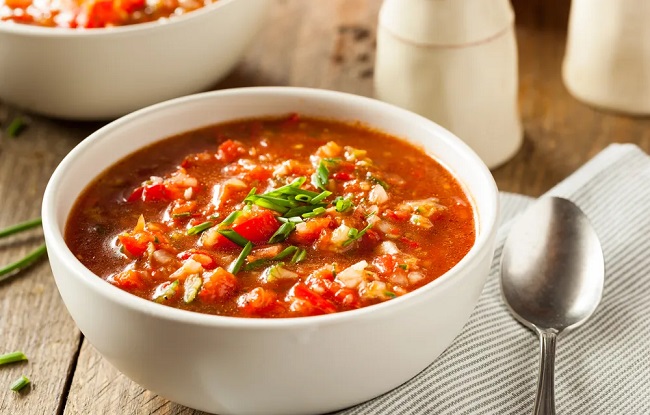In my early twenties, I went to a dinner party that was trying a little too hard. The meal began with bowls of cold Happy Shopper tomato soup, which was topped with cucumber slices, cayenne pepper, and a giant green pepper, the kind you get from the kebab truck.
The host, who had just returned from a year in Spain, confidently identified the dish as gazpacho. Fantastic, as my left-hand side companion put it. “I’m looking for the microwave.”
Its Called Best Gazpacho
We Brits have always been wary of chilled soups, thinking they taste strange and being out of place in our environment, which calls for tartan vacuum flasks and hot broths.
Yet just as we’ve warmed to tapas and the pungent pleasures of goat cheese and garlic, so too have we reluctantly come to appreciate the benefits of a cool, liquid lunch during our infrequent heat waves.

“At home, a dog of any breeding would refuse to sully its nose with such a compromising concoction,” the 19th-century French writer Theodore Gautier is quoted as saying by Elizabeth David.
Strange as it may appear the first time one tries it, he says, “one ends up getting used to it and even like it.” Even this sophisticated Parisian succumbs to the “hell- broth’s” spell. It’s the same for us.
Read Also:
- How Many Calories Are in A Chipotle Tortilla
- Half Down Middle School Child Daughter Knickers
- Computational Paige 100m Casdin Johnson Johnson
In A Celebration of Soup, Lindsey Bareham calls gazpacho “a salad soup,” which is a perfect way to describe this delicious dish full of ripe, summery flavours. It’s a cuisine created by Andalusian peasants to make the most out of limited resources.
Bread, olive oil, garlic, and water are the only ingredients listed in the earliest recipes; tomatoes and peppers, imported from the New World, are added considerably later. Like any delicious salad, it may be made with whatever is in season, with “ripe” being the crucial word in our country; if you want your tomatoes and peppers to shine, don’t use them in the dead of winter.
To make this worthwhile, you’ll need to go out of your way to track down high-quality components. The primary point of disagreement over a traditional gazpacho recipe is whether or not to use bread.
Despite being a staple since the soup’s mediaeval inception, bread isn’t included in Elizabeth David’s recipe for Mediterranean Cuisine. Instead, she uses a combination of less usual components including chopped olives and marjoram.
Salmorejo is a simplified version of gazpacho consisting of garlic, vinegar, olive oil, tomatoes, and loads of bread. Yet, I have seen it incorrectly referred to as salmorejo online.
For this experiment, I will prepare a basic gazpacho and then attempt to recreate it without using any bread. I put 300 grammes of ripe tomatoes, a third of a cucumber, a ripe red pepper, and a chopped garlic clove into a blender with a crumbled up slice of slightly stale, crusty white bread and blend until smooth.
I put in 3 tablespoons of extra virgin olive oil and 1 teaspoon of sherry vinegar. It can be made into a soup by adding a few tablespoons of cold water, after which it can be seasoned and refrigerated, much like when I prepare mine without bread.
You shouldn’t add any liquid to this. After trying both, I can say that the bread makes the soup feel more like a thick salsa and gives it the necessary substance. Now that we know bread is essential, I need to figure out when to include it.
When preparing dishes from Jenny Chandler’s The True Taste of Spain, the cook is instructed to soak the bread in water for at least an hour before using it—a recommendation backed by no less an authority than Elena Meneses de Orozco, the wife of the previous Spanish Ambassador to London.
I’m not entirely sure why it’s necessary to remove the bread’s moisture before mixing it with the veggies, but I think this is so. After making the traditional gazpacho with dry breadcrumbs, I decide to prepare a second batch using soaked bread to compare the two.
Even though I can’t quite put my finger on why, I’ve decided that soaking is a good thing because the result requires less water to reach a soupy consistency while yet holding together better.
Now that we’ve solved the bread problem, we can go on to considering alternatives. My friend Jenny Chandler tells me to cut the stem off of my tomatoes and remove the seeds. For Lindsey Bareham, I only need to peel them, and Senora Meneses has only asked that they be diced.
As the soup is strained through a sieve after blending, the first two seem unnecessary, but I cross-cut my tomatoes, blanch them for 20 seconds in hot water, peel and deseed them, and hope against hope that it makes no difference.
The completed soup strains more easily through the sieve, but the taste seems unaffected, so I give up on the experiment. The soup, according to Lindsey Bareham, is even better with the addition of tomato concentrate (one tablespoon for every 700g of tomatoes) (as does Gordon Ramsay).
It seems dishonest to do so, but I give it a shot anyway and am pleasantly surprised by how well it blends in with the ripe tomatoes; in fact, I’m not sure it’s even required. (And since we’ve proven that it’s pointless to make it with anything less than obscenely ripe ingredients, you can put away the puree.)
Here come the finishing touches, the things that can transform a dish from passable to deserving of a post on your blog. I’m not referring to the heinous atrocities committed against this soup in the name of “modern twists,” such as the addition of lobster meat or mango pickle, but rather to simple enhancements that work with the soup’s existing flavours.
Red and green peppers should be used interchangeably in this dish by Elena Meneses de Orozco. I opt to keep them in since their herbaceous flavour is a nice contrast to the red versions’ sweetness and the tomatoes’ acidity.
On the other hand, the rich earthy character of Elizabeth David’s black olives appears out of place in a bowl of fresh, clean ingredients. So, I’m going to put them aside for a garnish. Onions, whether red, Spanish, or spring, are a staple in many kitchens.
I give all three a shot, but they dull the zesty, garlicky flavour that is key to a decent gazpacho, so I don’t recommend them. Another ingredient that is frequently advocated online but which should be avoided in this otherwise delightful soup is chilli.
Even though cumin and coriander seeds often pair well together, I find that they clash with the other flavours in this dish because freshness is the focus. Assuming your produce is fresh and your fridge is cool, the actual secret to gazpacho is good olive oil, and lots of it.
If you’re not a miserly farmer, then pour it in generous glugs and season it to taste with vinegar. Ideally, sherry would be used because gazpacho is an Andalusian meal, but red wine vinegar would do in a pinch.
Instead of adding ice cubes to the soup to chill it, which would dilute the flavour, prepare the soup ahead of time so it can chill in the refrigerator. Make sure everyone tries it before making excuses about cold soup, and consider using mint as a garnish (it’s very refreshing) or olives (they provide a nice rich, savoury aspect to the clean flavours of the vegetables).
Read Also:
Recipe for Flawless Gazpacho by Felicity
- 100 grammes of white bread, crusts removed, slightly stale; soak in cold water for 20 minutes
- tomatoes, 1 kilogramme, extremely ripe, diced
- Diced, deseeded red and green peppers (1 ripe red and 1 green)
- A cucumber, about medium in size, peeled and chopped
- Crushed and peeled garlic from 2 cloves
- 150 ml of 100% pure olive oil
- Add 2 tablespoons of sherry vinegar.
- A pinch of salt
- In the container of a food processor or blender, combine the diced tomatoes, peppers, and cucumber with the crushed garlic and olive oil. Pull the bread apart, rip it into large pieces, and throw it in.
- Using a blender, puree the ingredients until smooth. Season with salt and vinegar to taste, then mix thoroughly.
- Put the mixture through a fine sieve, cover, and chill in the fridge for at least an hour.
- Garnish it anyway you wish before serving; I personally enjoy it with chopped black olives, hard-boiled egg, cucumber, and pepper; however, mint or parsley also works well, and many people also like to add spring onion, cubes of Spanish ham, etc.






















